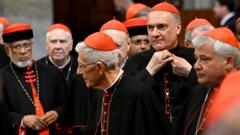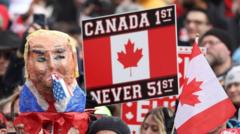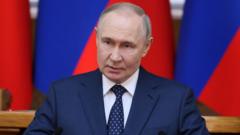The country's response to President Trump's trade policies and a surge in support for the Liberal Party set the stage for a historic vote.
Canada's Election Day: Who Will Lead Amid Economic Turmoil?

Canada's Election Day: Who Will Lead Amid Economic Turmoil?
Canadians head to the polls facing a transformative election sparked by shifting political dynamics and economic pressures.
Canadians are poised to cast their votes in what promises to be a pivotal election on Monday, targeting the future leadership of their nation amid pressing economic challenges and shifting political sentiments. With an unexpected turn in the campaign sparked by President Trump’s aggressive trade tactics, sentiment has shifted in favor of the Liberal Party led by recently appointed Prime Minister Mark Carney.
In recent weeks, polling data has shown the Liberals gaining momentum over the Conservative Party, which, under leader Pierre Poilievre, was previously miles ahead in the race. Carney, stepping in after former Prime Minister Justin Trudeau’s resignation, is positioning himself as the candidate best equipped to handle the complexities of U.S.-Canada relations, particularly in light of Trump's trade threats and remarks suggesting Canadian sovereignty is under threat.
Alongside the main political contenders, three additional parties—the New Democratic Party (NDP), the Green Party, and the Bloc Quebecois—are set to play minor roles in establishing the composition of Canada’s parliament, though their influence seems limited compared to the two leading parties.
As voters head to polling stations across the country, they face a backdrop of rising economic woes, largely attributable to soaring living costs and the repercussions of Trump's tariffs, which are creating concerns about potential unemployment and economic downturns. The housing crisis remains a central issue, especially in urban centers like Toronto and Vancouver, where rising rents and home prices are squeezing middle-class families.
As Carney appeals to voters with a decisive stance against Trump’s economic policies, Poilievre draws on a more conservative platform promising reduced government interference. The full impact of presidential influence has become increasingly apparent, as Trump attempted to sway Canadian opinion through social media, stirring anger among voters who prioritize national sovereignty.
Election day marks a crucial juncture for Canada, where the distribution of votes will significantly determine the next leader and the course of the nation during an economically precarious time. Polls opened across the six Canadian time zones, allowing for staggered voting until the evening hours, with early results anticipated shortly after vote closure.
As this transformative election unfolds, all eyes are on Canada as it navigates its path forward amidst economic uncertainty and challenges to national identity.
In recent weeks, polling data has shown the Liberals gaining momentum over the Conservative Party, which, under leader Pierre Poilievre, was previously miles ahead in the race. Carney, stepping in after former Prime Minister Justin Trudeau’s resignation, is positioning himself as the candidate best equipped to handle the complexities of U.S.-Canada relations, particularly in light of Trump's trade threats and remarks suggesting Canadian sovereignty is under threat.
Alongside the main political contenders, three additional parties—the New Democratic Party (NDP), the Green Party, and the Bloc Quebecois—are set to play minor roles in establishing the composition of Canada’s parliament, though their influence seems limited compared to the two leading parties.
As voters head to polling stations across the country, they face a backdrop of rising economic woes, largely attributable to soaring living costs and the repercussions of Trump's tariffs, which are creating concerns about potential unemployment and economic downturns. The housing crisis remains a central issue, especially in urban centers like Toronto and Vancouver, where rising rents and home prices are squeezing middle-class families.
As Carney appeals to voters with a decisive stance against Trump’s economic policies, Poilievre draws on a more conservative platform promising reduced government interference. The full impact of presidential influence has become increasingly apparent, as Trump attempted to sway Canadian opinion through social media, stirring anger among voters who prioritize national sovereignty.
Election day marks a crucial juncture for Canada, where the distribution of votes will significantly determine the next leader and the course of the nation during an economically precarious time. Polls opened across the six Canadian time zones, allowing for staggered voting until the evening hours, with early results anticipated shortly after vote closure.
As this transformative election unfolds, all eyes are on Canada as it navigates its path forward amidst economic uncertainty and challenges to national identity.






















